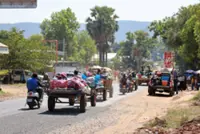Illustrative photo of Sungai Golok.
BANGKOK: Malaysia has undertaken extensive measures under the Cross-Border Collaboration initiative with Thailand through the Golok River Mouth Improvement Project to mitigate frequent flooding and improve the quality of life for communities along Sungai Golok.
Malaysian Deputy Prime Minister Datuk Seri Fadillah Yusof said the river, which forms a natural border between Malaysia and Thailand, has long been prone to flooding, severely affecting local communities.
"Mitigating floods at the Sungai Golok estuary necessitates a blend of engineering solutions, environmental management, and policy measures to address sedimentation, regulate water flow, and reduce flood risks,” he said.
To tackle these challenges, he said the Malaysian government has implemented comprehensive initiatives as part of the Cross-Border Collaboration between Malaysia and Thailand.
Fadillah, who is also the Minister for Energy Transition and Water Transformation, said this during a courtesy call on Thailand’s Deputy Prime Minister Prasert Jantararuangtong at the Government House on Friday, held in conjunction with his three-day working visit to Thailand.
He said the agreements between the governments of Malaysia and Thailand on the Golok River Mouth Improvement Project have been in place since 1997 through the Joint Evaluation Team (JET), the Joint Technical Working Group (JTWG), and the Joint Steering Committee (JSC).
"To mitigate the impact and risks of flooding during the monsoon season, Malaysia plans to conduct dredging at the Sungai Golok estuary and construct a river dyke or groyne by the end of 2025, subject to approval of the JTWG and the Thai government,” he said.
He also said both countries agreed during the 40th JTWG meeting to continue discussions in the upcoming JET and JTWG meetings, with updates to be presented at the next JSC meeting later this year.
Fadillah said that Malaysia is set to complete a post-monsoon sedimentation survey by April 2025 and highlighted that the sediment levels have exceeded the Tidal Mean Sea Level (TMSL) threshold, necessitating dredging activities.
He also said that Malaysia has secured funding for the additional scope of work planned.
Meanwhile, Prasert, who is also the Minister of Digital Economy and Society, welcomed Malaysia’s initiative and confirmed that his ministry has coordinated with Thailand’s Ministry of Agriculture and Cooperatives to support project implementation.
During his official visit to Thailand in April, Malaysian Prime Minister Datuk Seri Anwar Ibrahim witnessed the signing of a Memorandum of Understanding (MoU) on the Construction Agreement (CA) for the Rantau Panjang-Sungai Golok Bridge Project.
The project is expected to significantly enhance connectivity, trade, and relations between the two nations.
In 2024, Thailand ranked as Malaysia’s seventh-largest trading partner globally and third-largest within Asean, with total trade amounting to US$25.03 billion (RM114.56 billion). - Bernama





